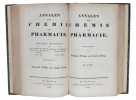3 books for « mayer julius robert »Edit
-
Language
French (2)
Russian (1)
-
Topics
Biology (1)
Physics (1)
Tea (1)
-
Countries
Denmark (2)
United States of America (1)
Zakon sokhraneniya i prevrashcheniya energii. In Russian /The Law of Energy C...
"Short description: In Russian. Mayer, Julius Robert. The Law of Energy Conservation and Transformation. Moscow; Leningrad: State Technological and Theoretical Publishing House, 1933. Zakon sokhraneniya i prevrashcheniya energii. In Russian /The Law of Energy Conservation and Transformation. Please feel free to contact us for a detailed description of the copies available. SKU9306367"
"MAYER, J.R. (JULIUS ROBERT). - THE FIRST STATEMENT OF THE CONSERVATION OF ENERGY.
Reference : 46883
(1842)
Bemerkungen über die Kräfte der unbelebten Natur.
Heidelberg, C.F. Winter, 1842. Bound in a nice later hcalf. Raised bands, titlelabel with gilt lettering. In: ""Annalen der Chemie und Pharmacie. herausgegeben von Friedrich Wóhler und Justus Liebig"", Vol. 42. (6),356 pp. Mayer's paper: pp. 233-240. Volume 42 is offered bound together with vol. 41. (8),376 pp. a. 1 folded plate. (This volume contains importent cehemical papers by Kolbe, Cahours, Kopp, Wöhler, Laurent and Liebig (the first printing of Liebig's famous work on animal physiology and pathology)
First printing of one of the most important papers in physics, chemistry and physiology in the 19th century. The paper is the first to propose an equivalence of all forms of energy, including heat, and a conservation of total energy. Although Mayer was the first to set forth the general law of the conversation of energy (the first thermodynamical law), it was James Joule who first put the law on firm footing. ""The paper of 1842 (the paper offered) set out Mayer’s definitive view on the conservation of force and established his claim to priority"" historically the paper also provides insight into the processes through which Mayer arrived at his theory.""(DSB).""Originally trained as a physician, mayer did not enjoy medical practice. About 1840 he began to be interested in physics and he entered thhe field of research, ... In 1842 he not only presented a figure for the mechanical equivalent of heat, but he also clearly presented his belief in the conversation of energy. He had some difficulty getting his paper on the subject published but Liebig finally accepted for the importent journal he edited. Though Mayer was five years ahead of Joule his paper aroused no interest, and in the end it was Joule, with his imposing experimental background. who received credit for working out the mechanical equivalent of heat. And it was Helmholtz who recieved credit for announcing the law of conservation of energy because he announced it so much more systematically. Yet Mayer went further than either of the other two, for he included living phenomena in the realm of energy conservation (a daring step in a decade when vitalism, with its view that the laws of inanimate nature did not apply to living systems, was still a considerable force). Mayer argued that solar energy was the ultimate source of all energy on earth, both living and non-living. He further suggested that solar energy was derived from the slow contraction of the sun, or by the fall of meteors into the sun, in either case kinetic energy being converted to radiant energy.""(Asimov)""After 1860, Mayer was finally given the recognition he deserved. Many of his articles were translated into English, and such well-known scientists as Rydolph Clausius in Germany and John Tyndall in England began to champion Mayer as the founder of the law of the conservation of energy.""(Alan Lightman ""Great Ideas in Physics"", p. 8).Parkinson ""Breakthroughs"" 1842 P. - Magee ""A Source Book in Physics"", p. 196 ff. - Dibner: 157 (listing the offprint with a different title) - PMM: 330 (offprint-version). - Garrison & Morton: 606.
Die organische Bewegung in ihrem Zusammenhange mit dem Stoffwechsel. Ein Beitrag zur Naturkunde. - [EXPANDING THE ""CONSERVATION-OF ENERGY"" PRINCIPLE]
Heilbronn, C. Drechsler'schen Buchhandlung, 1845. 8vo. Nice later hcalf bound to style (pastiche). Marbled covers. Richly gilt spine, titlelabel with gilt lettering. (2),112,(2) pp. Title-page with some brownspots, some scattered brownspots. Printed on good paper.
Scarce first edition - Mayer's MAGNUM OPUS - of this his most original and comprehensive paper, privately printed, BEEING THE WORK THAT FOR THE FIRST TIME INCLUDED LIVING PHENOMENA IN THE REALM OF ENERGY CONSERVATION. In this work Mayer again set out the physical basis of his theory, - in 1842 he was the first to present a figure for the mechanical equivalent of heat, and also stated his belief in the conservation of energy - ""this time extending the ideal of force conservation to magnetic, electrical, and chemical forces. In Die organische Bewegung he described the basic force conversions of the organic world. Plants convert the sun’s heat and light into latent chemical force" animals consume this chemical force as food" animals then convert that force to body heat and mechanical muscle force in their life processes.""(DSB).Mayer submitted this paper to Liebig's Annalen but it was rejected by an assistant editor. The assistant's advice was to try Poggendorff's Annalen, but mayer did not care to foloow that publication route again. In the end, he published the paper privately, and hoped to gain recognition by distribiting it widely. But beyond a few brief journal listings, the paper, Mayer's magnum opus, went unnoticed.""After 1860, Mayer was finally given the recognition he deserved. Many of his articles were translated into English, and such well-known scientists as Rydolph Clausius in Germany and John Tyndall in England began to champion Mayer as the founder of the law of the conservation of energy.""(Alan Lightman ""Great Ideas in Physics"", p. 8).
 Write to the booksellers
Write to the booksellers







